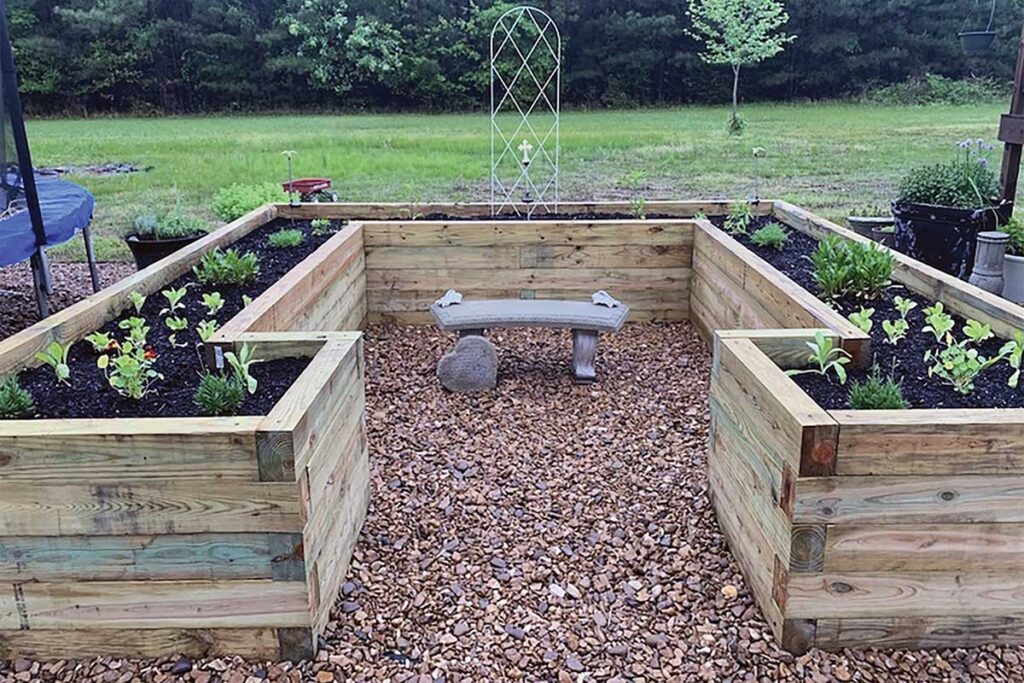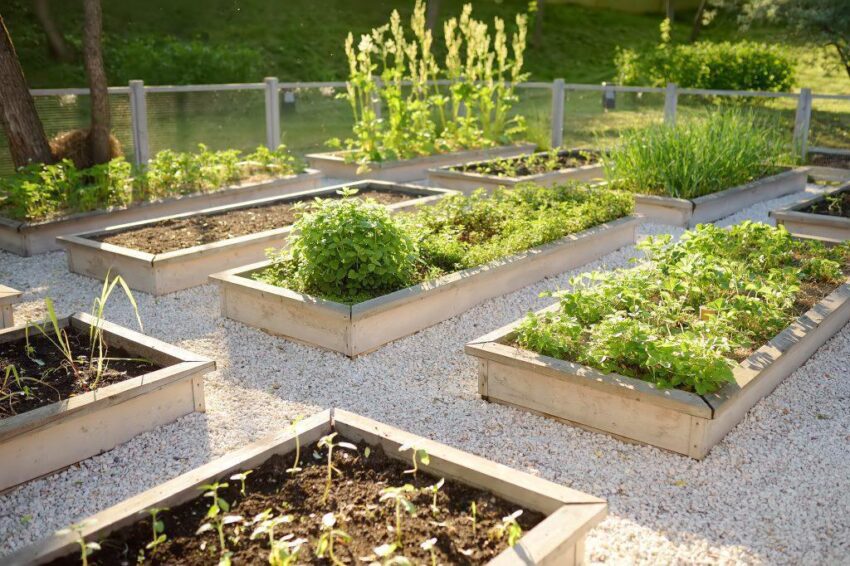Raised bed gardens are one of the best ways to grow vegetables, herbs, and flowers at home.
They give you better soil, easier weeding, and faster harvests.
They work well in small yards, terraces, and even on patched lawns.
This guide shows you how to plan, build, fill, plant, and care for raised beds — step by step — with India-friendly gardening tips.
Why Choose a Raised Bed Garden?
- Better drainage and fewer waterlogging problems.
- Warmer soil in early season for faster growth.
- You control the soil mix (no heavy clay or poor subsoil).
- Easier on the back — no deep bending.
- Great for small spaces and urban backyards in India.
Quick Overview: Depth, Width, and Location

- Depth: For most vegetables aim for 30–45 cm (12–18 in) of good soil. Taller crops like tomatoes and chillies do best with 45 cm or more. Shallow herbs and lettuce need only 15–20 cm.
- Width: Keep beds no wider than 90–120 cm (3–4 ft) so you can reach the centre from both sides. A single-row bed can be narrower (45–60 cm).
- Length: Any length is fine. Make paths 60–90 cm so two people can pass.
- Sun: Place beds in the sunniest spot you have. Most vegetables need 5–6+ hours of direct sunlight.
Materials You Need for Building a Raised Bed
Frame options:
- Untreated timber (shisham, teak, neem wood). Avoid chemically treated wood.
- Bricks, stone, or concrete blocks for a permanent garden bed.
- Recycled sleepers or composite boards.
- Galvanised raised planters or metal troughs for balconies.
Soil and filling materials:
- Good compost or well-rotted cow dung manure.
- Cocopeat or coir pith for water retention.
- Perlite, sand, or coarse river sand for drainage.
- Native garden soil or loam.
Extras for better performance:
- Landscape fabric or cardboard (weed barrier).
- Mulch: straw, dry leaves, sugarcane bagasse.
- Drip irrigation kit or soaker hose (recommended for water saving).
Also Read Eating Seasonally for Better Nutrition: A Healthy and Sustainable Choice for Indian Diet
Step-by-Step Guide to Build a Raised Bed
- Clear and level the spot. Remove weeds or turf.
- Lay a weed barrier. Use cardboard or fabric to stop grass growth.
- Assemble the frame. Nail or screw timber into a rectangle, or arrange bricks/stones.
- Add optional legs. For waist-height beds, use strong supports.
Best Soil Mix for Raised Bed Gardening
A simple soil recipe (by volume):
- 40–50% compost or well-rotted dung manure
- 25–35% cocopeat or coir
- 15–25% coarse sand or perlite
- A handful of lime (if soil is acidic) and organic fertiliser.
This makes the soil light, fertile, and well-draining — perfect for vegetables and herbs.
How to Fill a Raised Bed
- Topsoil + Compost Mix – best for small beds, ready to use immediately.
- Potting Mix Style (Mel’s Mix) – equal parts compost, coir, and sand/perlite. Great for vegetables and herbs.
- Layering Method (Lasagna or Hügelkultur) – bottom layer of cardboard, then wood, green matter, straw, and top layer of compost. Cheaper and builds soil over time.
Watering Raised Beds
- Raised beds dry faster than ground soil.
- Water early in the morning.
- Use a drip irrigation system or soaker hose for efficiency.
- Mulch with straw or dry leaves to reduce evaporation.
Planting and Layout
- Place tall plants like tomatoes, okra, and beans on the north side so they don’t shade shorter crops.
- Companion planting works well: grow marigolds, basil, coriander, or mint alongside vegetables to repel pests.
- Rotate crops each season to keep soil healthy.
Easy Crops to Grow in Raised Beds in India
- Leafy Greens: spinach, methi (fenugreek), mustard greens, lettuce.
- Quick Harvests: radish, spring onion, coriander.
- Vegetables: tomato, chilli, brinjal, okra, beans.
- Herbs: basil, mint, curry leaf, dill.
Seasonal Gardening Tips for India
- Summer: Use mulch and shade nets to protect young plants.
- Monsoon: Ensure beds have good drainage to prevent waterlogging.
- Winter: Perfect season for leafy greens and root crops like carrots and radish.
Common Problems and Solutions
- Shallow beds: Root crops won’t grow well. Solution: increase depth to 30–45 cm.
- Compacted soil: Roots won’t spread. Solution: mix compost and sand.
- Overwatering: Leads to root rot. Solution: ensure drainage and water only when topsoil is dry.
- Overcrowding: Plants get weak. Solution: respect spacing guidelines.
Cost-Saving and Sustainable Gardening Tips
- Start small with 1–2 beds.
- Compost kitchen scraps to make free fertiliser.
- Collect rainwater for irrigation.
- Use recycled bricks, wood, or containers.
FAQs on Raised Bed Gardening
Q1. How deep should raised beds be for tomatoes and chillies?
At least 40–45 cm for healthy root growth.
Q2. Can I build a raised bed on concrete?
Yes, just ensure good drainage and use a proper soil mix.
Q3. What is the best soil mix?
40–50% compost, 25–35% cocopeat, 15–25% sand or perlite.
Q4. Is drip irrigation necessary?
Not compulsory, but highly recommended for water saving and healthy plants.
Q5. Can I use kitchen scraps directly in raised beds?
Better to compost them first. Raw scraps can attract pests.
Final Words
Raised bed gardening in India is one of the most effective ways to grow your own food.
It gives you control over soil, reduces effort, and increases harvest.
Start small, use good compost, water wisely, and plant seasonal crops.
With regular care, your backyard raised bed will provide fresh vegetables and herbs for your family year-round.
Author- Ayush
